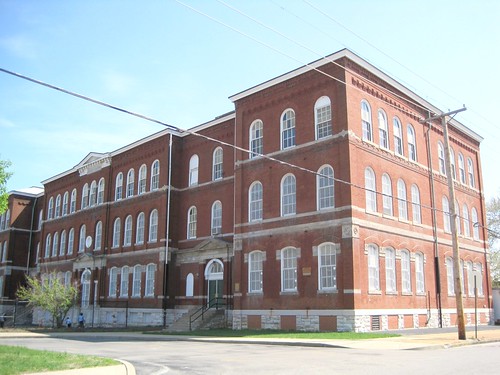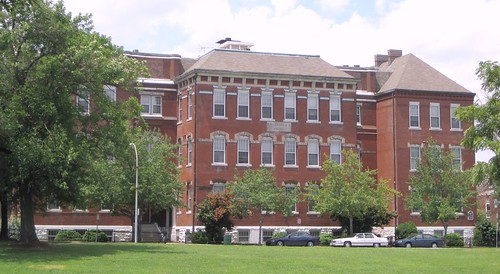by Lindsey Derrington
This article is adapted from a National Register of Historic Places Eligibility Assessment that the Preservation Research Office submitted to the Missouri State Historic Preservation Office. The response from the State Historic Preservation Office is emphatic: “What a waste it would be if this lovely schoolhouse were to be demolished. Hodgen Elementary School is clearly eligible for listing in the National Register of Historic Places under Criterion C for Architecture, and may be eligible under Criterion A for Education as well,” states the response dated March 23, 2011.

History of Hodgen School
Hodgen Elementary School is located on the southeast corner of Henrietta and California Streets in the Eads Park neighborhood of St. Louis’ Gate District, bounded by Jefferson and South Grand avenues to the east and west and Chouteau Avenue and Interstate 44 to the north and south. Characterized by middle class row houses and multiple-family flats, this area developed in the early 1880s and 1890s as part of the Compton Hill District, today known as the Compton Heights and Fox Park neighborhoods.

Plans for Hodgen Elementary were drawn during the summer of 1883 at the behest of local residents to accommodate the rapidly-growing area’s needs. Otto Wilhelmi, elected Architect and Superintendent of Repairs by the city’s school board earlier that year, was responsible for its design. Hodgen was his first, if not only, design for a new school building for the district, and was named for nationally-renowned surgeon and educator Dr. John Thompson Hodgen who had died in 1882.
Hodgen Elementary was completed for $32,330 in mid-1884. It stood three stories tall with a full basement and contained fourteen rooms, each with access to four large windows to provide students with the maximum amount of light. The school was well-received by the school board and the community. Soon the neighborhood’s burgeoning population necessitated a six room addition that added three bays to both the school’s east and west facades. H. William Kirchner, who had served as school board architect during the term prior to Wilhelmi’s and was elected again in 1886, designed the addition. His brother August H. Kirchner served as school board architect from 1893 to 1897 and in 1894 designed another three-story addition to Hodgen to bring it to its present appearance. This addition added a four bay wing to the building’s east façade and a three bay wing to its west façade at a cost of $15,000. William B. Ittner almost certainly oversaw $103,948 worth of alterations to the school in 1909, though the nature of this work is unknown.
The construction of I-44 just south of Lafayette Avenue in the early 1960s isolated Hodgen and the northern part of the Compton Hill region, driving away many residents and spurring waves of demolitions. In 1991 the City of St. Louis commissioned the nationally-renowned firm Duany Plater-Zyberk to execute a redevelopment plan for the area. Their plan called for extensive infill construction and historic rehabilitation of remaining buildings, and branded the area “The Gate District†while identifying smaller neighborhoods within its boundaries. Hodgen Elementary continued to serve the area, receiving over $400,000 worth of renovations in the late 1990s before the school district constructed new facilities to its immediate west in 2001. The original Hodgen Elementary was subsequently closed, and has been vacant since. It remains the Gate District’s sole historic school building, and although an excellent candidate for rehabilitation, the school district currently plans to demolish the building for additional parking and recreational facilities for the new school building.
Significance
Hodgen School is locally significant under Criterion C for Architecture. It is the only known school building designed by Otto Wilhelmi during his 1883-1886 tenure as Architect and Superintendent of Repairs, and represents a transitional period between the cramped, cruciform corner-room plans typical of schools from the 1860s and 1870s, and the advent of architect William B. Ittner’s groundbreaking, expansive school designs documented by the St. Louis Public Schools of William B. Ittner Multiple Property Submission.
Born in Gray Summit, Missouri in 1853 to German parents, Otto Wilhelmi moved to St. Louis with his family at a young age. He attended Washington University before studying architecture in France and Italy and at the Karlsruhe Polytechnic in Germany in the late 1870s. Upon his return he entered a brief partnership with Ernst Janssen, another young German-American architect, before accepting his position with the St. Louis Public Schools. During this time he oversaw a number of renovations to earlier school buildings and executed designs for Hodgen, making it one of his earliest extant works. The Landmarks Association of St. Louis did not document any other Wilhelmi-designed schools in its Pre-1938 St. Louis Public Schools survey (1988), meaning that Hodgen is either his only school design or his only extant school design. Wilhelmi went on to establish his own firm, designing substantial homes in the in the Shaw, Compton Heights (a total of eight between 1891 and 1895), and Skinker-DeBaliviere/Catlin Tract/Parkview local historic districts. He also designed the Strassberger’s Conservatory (NR 3/27/80) and the Winkelmeyer Building (NR 7/11/85). He was regarded as one of the city’s leading German-American architects before his death in 1925.

Wilhelmi’s “architectural style” for Hodgen Elementary was regarded as “somewhat different from that of any of the present school buildings” by the St. Louis Globe-Democrat in 1883; its Classical Revival details were quite different from the High Victorian Gothic details of H. William Kirchner’s 1882 Blair School (NR 2/10/83), the city’s only other extant school building from the early 1880s, and from the earlier starkly-articulated predecessors designed by Frederick W. Raeder (these include Carondelet School, NR 3/21/2007).

Much comment was made on Hodgen’s ample lighting and interior arrangements, setting it further apart from St. Louis’ school buildings of the 1860s and early 1870s. H. William and August H. Kirchner’s subsequent alterations to Hodgen were in keeping with Wilhelmi’s original design, maintaining the building’s compositional whole while illustrating the intentional flexibility of these early school designs executed to facilitate future growth and easy expansion. William B. Ittner succeeded Kirchner in 1897, applying his modern and often experimental design strategies to innovate with earlier school prototypes both locally and nationally; Wilhelmi’s Hodgen Elementary is an excellent example of a late nineteenth-century, pre-Ittner school, representative of a unique period in the evolution of local school design.
Site Plan

Bibliography
Duany Plater-Zyberk. “The Gate District: Missouri.†Project Information Sheet. Web.
“Hodgen School.” Source unknown,1922. Missouri Historical Society St. Louis Schools Scrapbook.
“Is No Stint.” St. Louis Post-Dispatch. 12 October 1893.
Landmarks Association of St. Louis. Final Report: Pre-1938 St. Louis Public Schools Survey. 15 July 1988.
Leonard, John W., ed. The Book of St. Louisans: a Biographical Dictionary of Leading Living Men of the City of St. Louis. St. Louis: St. Louis Republic, 1912.
“Local News.” St. Louis Post-Dispatch. 5 May 1888.
“Otto J. Wilhelmi, Architect, Dies at 71.” Source unknown. 24 April 1925. Missouri Historical Society Necrology Scrapbooks.
“School Houses Wrecked.” St. Louis Post-Dispatch. 29 May 1896.
“The Hodgen School.” St. Louis Globe-Democrat. 4 August 1883.
“The Hodgen School.” St. Louis Globe-Democrat. 12 July 1884.
“The New Hodgen School.” St. Louis Globe-Democrat. 10 September 1883.
“The Public Schools.” St. Louis Globe-Democrat. 16 February 1884.
“The School Board.” St. Louis Globe-Democrat. 10 January 1883.
Toft, Carolyn Hewes and Jane Molloy Porter. Compton Heights: A History and Architectural Guide. St. Louis: Landmarks Association of St. Louis, 1984.
Wayman, Norbury. “History of St. Louis Neighborhoods: Compton Heights.†Web.

8 replies on “Hodgen School “Clearly Eligible” for National Register”
Clearly it should be rehabbed into condos. If not now then secure it and wait 5 years. Perhaps a fundraiser to create awareness over in Lafayette Square?
do you think this’ll convince the super and SAB to NOT demolish Hodgen? the thought of it is just disgusting… and for a damn PARKING LOT no less! (oh, yeah, and a “playground for the children” to make it sound like it’s not just about getting more convenient parking and getting rid of a financial liability. YOU ARE ADJACENT TO A PARK.)
but anyway, might this have an effect on the outcome?
If the SLPS used federal funds in any way for the demolition, this ruling could forestall demolition. Using local funds, it’s still incumbent upon us to persuade the district to do the right thing in light of the facts.
thanks for the response, michael. so, more letters and phone calls… i wish there were a way to gauge whether or not our pleas are having any effect. perhaps i’m cynical, but i imagine that they simply ignore the calls and letters as they consider themselves the experts.
[…] the William P. Thompson House in the Trenton vicinity, the Delmo Community Center in Homestown, the Hodgen School Building in St. Louis City, and the Oak Grove Mausoleum and Chapel in St. Louis County. More detailed […]
Dr Hodgen was not only a renowned surgeon, he was the first “surdeon general” of Missouri and founded the first Veterans Hospital here is St Louis.
What a shame to let his memory die for a parking lot.
[…] Hodgen School rose from the good soil of St. Louis in stages starting in 1884. Then, 128 years later, the St. […]
[…] cause. The city stands bereft of one more monument to its former aspirations, the red brick Hodgen School that stood at California and Henrietta avenues until just two weeks ago. Yesterday, workers from […]